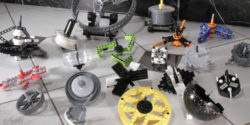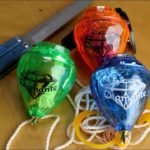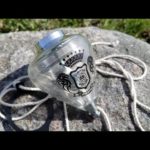Peg tops are made to be started in midair with a string and a throw. Where the top lands — on the ground, on the string, or in the hand — is up to the player.
The amazing tricks skilled players perform with peg tops make it easy to forget that peg tops also do rather interesting things when left to their own devices on hard, low-friction surfaces like polished stone floors or countertops. To fully appreciate that side of the peg top, best to view it up close at eye level, totally undisturbed. And for that, best to have a controlled start without the vagaries of strings and landings.
But high critical speeds and lack of suitable finger grips make peg tops very hard to start by hand. Hence the LEGO peg top starters demonstrated here with my 3-inch Relampago peg top (R3 for short). This prized possession was designed and 3D-printed by world-class player Jose Madrigal.
Each of the 2 starters shown consists of a driver and a peg top adapter. Both use the same high-powered wind-up driver based on an old LEGO motor for pull-back cars (motor6 on BrickLink). The 2 interchangeable adapters are basically friction clutches with 3 evenly spaced rubber-tipped fingers designed to grip a peg top’s crown or shoulder from above.
The first adapter works best with peg tops with caps bearing center holes or dimples (videos coming soon). Hence the short black centering guide just above finger level. The R3’s large open crown makes centering more difficult, but the challenge can be overcome with practice or the centering guide extension shown.
To make R3 centering easier, I also made a self-centering R3-only adapter. I show it here with a centering guide extension, but with a little practice, the adapter actually easier to use and more effective without it.
With this driver and either of the adapters, the R3’s best spin time (to first scrape) is 150 s, with the first 125 s of that spent in “sleep mode” (quiet vertical spinning with negligible tilt, precession, and nutation). During a rapidly evolving “transition mode” lasting a few seconds at most, the R3 then drops into a surprisingly long-lasting “terminal mode” characterized by rapid precession at large tilt just shy of scraping. In the R3, nutation (bucking motion at 2:53 to 3:16) marks early terminal mode.
Every peg top I’ve managed to start in sleep mode goes through this same sleep/transition/terminal mode sequence. That includes the QSH, Bearing King, Trompos Space Saturno, and Yoyo Empire Spintop (videos coming soon). The last stays up longest of all: 243 s total, 210 s sleep, 3 s transition, 30 s terminal).

Jeremy McCreary
Lego spintop crafter

Most of the videos here are extracted from my MOCs pages there and are working gizmos born of a fascination with gadgets and the science and engineering behind them. Technical LEGO® — my term for the fusion of LEGO® with STEM (science, technology, and math) subject matter — brings out my inner inventor/designer/engineer/toymaker like no other medium.
My work owes a great deal to the folks on my list of favorite builders. Their imagination and ingenuity never cease to amaze.





